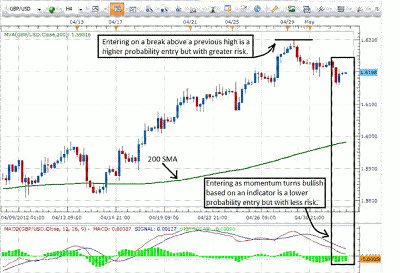While one is conservative and another more aggressive, these two entry strategies for GBP/USD are equally valid, explains Richard Krivo of DailyFX.com, leaving traders to choose which is most suitable for them.
In our ongoing quest to only take higher-probability trades, one of our key rules (if not the key rule) is that we only want to take trades in the direction of the trend on the daily chart, as they will have a greater likelihood of success.
We know we want to look for technical reasons to buy the GBP/USD for the following reasons:
- Price action is above the 200-period simple moving average and pulling away from it;
- Price action has been making higher highs and higher lows;
- At the time of this chart, the GBP was strong and the USD was weak, and…
- On the daily chart, the pair is in an uptrend.
Now that we know the direction we want to trade the pair, there are two ways represented on this four-hour GBP/USD chart to enter the trade in the direction of the trend.
The first and more conservative way is to enter later on a break of resistance at the previous high. The second and more aggressive way is to enter sooner when an indicator signals that momentum has shifted back in the direction of the trend.
The question that now begs asking is “Which way is best?”
Let’s take a look at the chart below for a visual:
Either entry would be considered a technically valid entry. As far as which is the best one will depend on the perspective of the trader in question.
While a break above the previous high is a compelling technical reason to enter a long position, the placement of the stop (red line) below the previous low can entail taking on a greater amount of risk.
On the other hand, when the red MACD line crosses above the blue signal line, it indicates that momentum has shifted to the upside on the pair. That can be an equally compelling technical reason to buy the pair. And, with the stop placed below the same previous low, we are taking on significantly less risk since our stop is closer to our entry.
So, in one instance (the break of resistance), we enter later with more risk but a greater probability for success. With the other (the MACD bullish crossover), we enter earlier with less risk but with a lower probability of success.
In this case, the trader is definitely presented with a classic “tradeoff” (no pun intended) scenario. Either take on more risk with a greater chance of success or risk less with a lower chance of success.
So…which entry strategy suits your trading style and personality the best? Let us know in the comments below.
By Richard Krivo of DailyFX.com



















